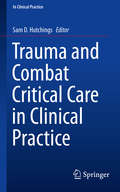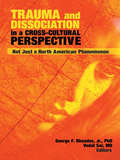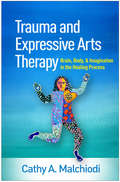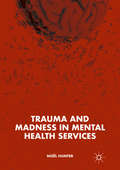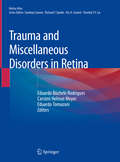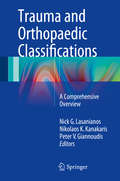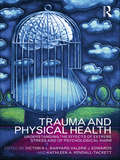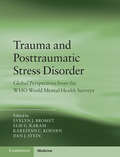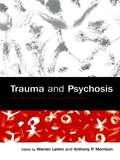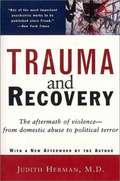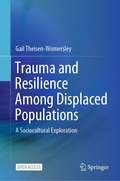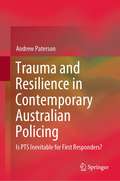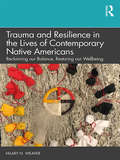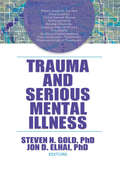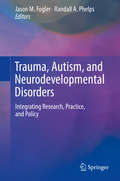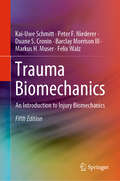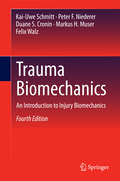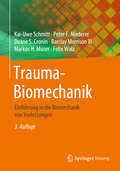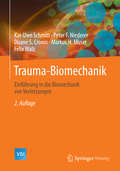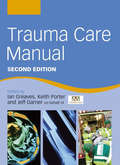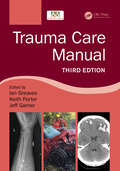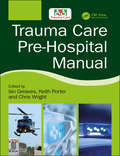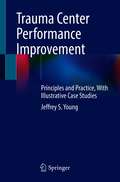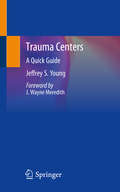- Table View
- List View
Trauma and Combat Critical Care in Clinical Practice
by Sam D. HutchingsIntensive Care Medicine (or Critical Care, the terms are used interchangeably) is an evolving specialty both within the UK and worldwide. It has recently been established as a UK speciality in it's own right, and is at the centre of the modern acute hospital, responsible for managing the sickest and most complex patients. There is a growing cadre of critical care specialists in the UK, underpinned by a large number of doctors in training within the specialty. Management of patients with severe traumatic injury is provided by intensive care specialists, often in conjunction with a range of other professionals such as surgeons and interventional radiologists. The management of these patients, who have competing complex injuries can be challenging. Traumatic injury is recognised as a significant cause of preventable mortality and such patients are now clustered within Major Trauma Centres across the UK. The Defence Medical Services of the UK have spent the last 10 years managing patients with very severe traumatic injuries, first in Iraq and most recently in Afghanistan. The lessons learnt from this experience has filtered through to the NHS, resulting in many changes to established practice. Whilst several books have been published based on this experience, none have focused on the intensive care management of such patients, which represents a vital link in the chain of survival from injury to recovery.
Trauma and Dissociation in a Cross-Cultural Perspective: Not Just a North American Phenomenon
by George F. Rhoades Vedat SarAn international look at the similarities and differences of long-lasting traumaTrauma and Dissociation in a Cross-Cultural Perspective examines the psychological, sociological, political, economic, and cultural aspects of trauma and its consequences on people around the world. Dispelling the myth that trauma-related dissociative disorders are a North American phenomenon, this unique book travels through more than a dozen countries to analyze the effects of long-lasting traumatization-both natural and man-made-on adults and children. Working from theoretical and clinical perspectives, the field&’s leading experts address trauma in situations that range from the psychological effects of "the Troubles" in Northern Ireland to the emergence of "Hikikomori," the phenomenon of social withdrawal in Japanese youth.Reactions to trauma can be both unique according to a person&’s culture and similar to the experiences of others around the world. Dissociation, intense grief, anger, and survivor&’s guilt are common responses as people split off mentally, physically, and emotionally from the source of the trauma, whether it&’s an act of nature (tsunami, earthquake, flood, etc.) or the trauma created by violence, physical, sexual, and emotional abuse, assault, confinement, kidnapping, and war. Trauma and Dissociation in a Cross-Cultural Perspective examines the efforts of clinicians and researchers in Europe, Asia, the Middle East, South America, Australia, and New Zealand to develop sociopsychological methods of providing counseling to people who are suffering physically, emotionally and spiritually, training for professionals counted on to dispense that counseling, and economic and political solutions that might help to limit the devastating effects of natural disasters. Trauma and Dissociation in a Cross-Cultural Perspective examines: the tensions between the National Health Service and the private sector in the United Kingdom how the Mandarin version of the Dissociative Experiences Scale (DES) is used in China Djinnai, a culture-bound syndrome and possession trance disorder found in Iran how colonialism has transmitted trauma to the Maori people of New Zealand transgenerational trauma in Turkey religious rituals and spirit possession in the Philippines "memory wars" in Israel traumatic syndromes among the French differences in dissociative experiences among Chinese and Japanese youth childhood trauma in Argentina and much moreTrauma and Dissociation in a Cross-Cultural Perspective is an enlightening professional resource for anyone working in psychology, sociology, psychiatry, and psychotherapy.
Trauma and Expressive Arts Therapy: Brain, Body, and Imagination in the Healing Process
by Cathy A. MalchiodiFrom pioneering therapist Cathy A. Malchiodi, this book synthesizes the breadth of research on trauma and the brain and presents an innovative framework for treating trauma through the expressive arts. The volume describes powerful ways to tap into deeply felt bodily and sensory experiences as a foundation for safely exploring emotions, memories, and personal narratives. Rich clinical examples illustrate the use of movement, sound, play, art, and drama with children and adults. Malchiodi's approach not only enables survivors to express experiences that defy verbalization, but also helps them to transform and integrate the trauma, regain a sense of aliveness, and imagine a new future. Purchasers get access to a companion website where they can download and print reproducible tools from the book in a convenient 8 1/2" x 11" size, as well as full-color versions of 26 figures.
Trauma and Madness in Mental Health Services
by Noël HunterHow do survivors of child abuse, bullying, chronic oppression and discrimination, and other developmental traumas adapt to such unimaginable situations? It is taken for granted that experiences such as hearing voices, altered states of consciousness, dissociative states, lack of trust, and intense emotions are inherently problematic. But what does the evidence actually show? And how much do we still need to learn?
Trauma and Miscellaneous Disorders in Retina (Retina Atlas)
by Eduardo Büchele Rodrigues Carsten Helmut Meyer Eduardo TomazoniThis atlas presents common and rare traumatic conditions of the retina and related intraocular tissues (choroidal rupture, commotio retinae, intraocular foreign body). It also covers intraocular tumors and congenital conditions such as myelinated retinal nerve fibers. Including numerous high-quality figures using various modalities, the book reviews the basic management principles in a reader-friendly style to help readers gain a better understanding of the diseases discussed.Trauma and Miscellaneous Disorders in Retina is one of nine volumes in the series Retina Atlas. This series provides comprehensive information on vitreoretinal diseases, covering imaging basics, retinal vascular disease, ocular inflammatory disease, retinal degeneration, retinal surgery, macular disorders, ocular oncology, pediatric retina and trauma.
Trauma and Orthopaedic Classifications
by Nick G. Lasanianos Nikolaos K. Kanakaris Peter V. GiannoudisThis illustrated textbook is an essential and invaluable guide to young clinicians and researchers of Trauma and Orthopaedics, reporting all classification systems which are currently utilised in the clinical setting. It includes classifications relevant to both Elective Orthopaedic Practice and Orthopaedic Trauma. Clear graphic illustrations accompany the description of all different classification schemes in a comprehensive manner, together with a structured presentation of existing clinical evidence. In this manner each chapter of the different anatomical sites and pathologies assists the decision making of the readers regarding treatment strategy as well as informed consent of their patients. It is envisaged that this textbook will be a point of reference not only to the surgeons in training (residents) but also to senior surgeons and academic clinicians.
Trauma and Physical Health: Understanding the Effects of Extreme Stress and of Psychological Harm
by Victoria Banyard Valerie Edwards Kathleen A. Kendall-TackettTrauma research and clinical practice have taught us much about the widespread problems of child maltreatment, partner violence, and sexual assault. Numerous investigations have documented links between such trauma exposure and long-term negative mental health consequences. As we learn more about traumatic stress, however, increasing attention has been drawn to the less studied physical health effects of maltreatment and trauma. Trauma and Physical Health describes both the negative physical health effects of victimization in childhood as well as exploring theoretical models that explains these links. By bringing together new and current studies on the relationship between trauma and physical health, this edited collection assesses the clinical implications of these links. At a time when the mental health field is becoming increasingly cognizant of the value of collaboration with professionals in the physical health arena, this book suggests ways in which clinicians can work with primary care professionals to better meet the needs of trauma survivors across the lifespan. A key focus of the text is to clarify the relationship between the current knowledge base in trauma and physical health and directions for future research in primary care health settings. With contributors from a wide range of clinical and psychological disciplines, it will be of interest to researchers, clinicians and professionals in the trauma field and to primary care professionals concerned with compassionate care for the traumatized.
Trauma and Posttraumatic Stress Disorder: Global Perspectives from the WHO World Mental Health Surveys
by Evelyn Bromet Elie Karam Karestan Koenen Dan SteinPosttraumatic Stress Disorder (PTSD) is a chronic, under-detected and under-treated psychiatric consequence of trauma that is often linked to new-onset medical and psychological conditions, impaired quality of life and long-term disability across the globe. This book is the first systematic analysis of the rates, risk factors, consequences and global burden of trauma and PTSD across a variety of wealthy and underdeveloped settings. An analysis of a global survey conducted by the World Health Organization and featuring findings from over 70,000 participants around the world, this text demonstrates a unique perspective on the prevalence of exposure to trauma and PTSD and the impact it has on population health. The findings inside this text underscore the urgent need for policymakers and healthcare providers to prioritize interventions aimed at reducing the burden of trauma, PTSD and its consequences.
Trauma and Psychosis: New Directions for Theory and Therapy
by Warren Larkin Anthony P. MorrisonTrauma and Psychosis provides a valuable contribution to the current understanding of the possible relationships between the experience of trauma and the range of phenomena currently referred to as psychosis. Warren Larkin and Anthony P. Morrison bring together contributions from leading clinicians and researchers in a range of fields including clinical psychology, mental health nursing and psychiatry. The book is divided into three parts, providing comprehensive coverage of the relevant research and clinical applications. Part I: Research and Theoretical Perspectives provides the reader with a broad understanding of current and developing theoretical perspectives. Part II: Specific Populations examines the relationship between trauma and psychotic experiences in specific populations. Part III: From Theory to Therapy draws together current knowledge and investigates how it might be used to benefit individuals experiencing psychosis. This book will be invaluable for clinicians and researchers interested in gaining a greater insight into the interaction between trauma and psychosis.
Trauma and Recovery: The Aftermath of Violence--from Domestic Abuse to Political Terror
by Judith Lewis Herman<p>When <i>Trauma and Recovery</i> was first published in 1992, it was hailed as a groundbreaking work. In the intervening years, Herman's volume has changed the way we think about and treat traumatic events and trauma victims. In a new afterword, Herman chronicles the incredible response the book has elicited and explains how the issues surrounding the topic have shifted within the clinical community and the culture at large. <p><i>Trauma and Recovery</i> brings a new level of understanding to a set of problems usually considered individually. Herman draws on her own cutting-edge research in domestic violence as well as on the vast literature of combat veterans and victims of political terror, to show the parallels between private terrors such as rape and public traumas such as terrorism. <p>The book puts individual experience in a broader political frame, arguing that psychological trauma can be understood only in a social context. Meticulously documented and frequently using the victims' own words as well as those from classic literary works and prison diaries, <i>Trauma and Recovery</i> is a powerful work that will continue to profoundly impact our thinking.</p>
Trauma and Resilience Among Displaced Populations: A Sociocultural Exploration
by Gail Theisen-WomersleyThis open access book provides an enriched understanding of historical, collective, cultural, and identity-related trauma, emphasising the social and political location of human subjects. It therefore presents a socio-ecological perspective on trauma, rather than viewing displaced individuals as traumatised “passive victims”. The vastness of the phenomenon of trauma among displaced populations has led it to become a critical and timely area of inquiry, and this book is an important addition to the literature. It gives an overview of theoretical frameworks related to trauma and migration—exploring factors of risk and resilience, prevalence rates of PTSD, and conceptualisations of trauma beyond psychiatric diagnoses; conceptualises experiences of trauma from a sociocultural perspective (including collective trauma, collective aspirations, and collective resilience); and provides applications for professionals working with displaced populations in complex institutional, legal, and humanitarian settings. It includes case studies based on the author’s own 10-year experience working in emergency contexts with displaced populations in 11 countries across the world. This book presents unique data collected by the author herself, including interviews with survivors of ISIS attacks, with an asylum seeker in Switzerland who set himself alight in protest against asylum procedures, and women from the Murle tribe affected by the conflict in South Sudan who experienced an episode of mass fainting spells. This is an important resource for academics and professionals working in the field of trauma studies and with traumatised groups and individuals.
Trauma and Resilience in Contemporary Australian Policing: Is PTS Inevitable for First Responders?
by Andrew PatersonThis book examines how fifty police officers in South Australia keep well and “bounce back” from duty-related traumatic experience in the absence of practical, accessible and timely organisational support. It investigates mechanisms police officers presently use to “normalise” their duty-related traumatic experiences to preserve the delicate professional balance between “coping” and “psychic numbing” and avoid the much publicised perils of a PTSD diagnosis, while being appropriately responsive to colleagues, victims and survivors in their daily work environment. By revealing how police officers manage trauma—outside of the expectations of mental health professionals, union representatives and police leadership—innovative approaches and recommendations are offered to support first responders in moving from assumptions of post-traumatic stress and through post-traumatic growth. The book considers recent advances in post-traumatic growth and resilience theory and reinterprets exposure in a positive context, as well as preventative experiences in Australia and internationally.
Trauma and Resilience in the Lives of Contemporary Native Americans: Reclaiming our Balance, Restoring our Wellbeing
by Hilary N. WeaverIndigenous Peoples around the world and our allies often reflect on the many challenges that continue to confront us, the reasons behind health, economic, and social disparities, and the best ways forward to a healthy future. This book draws on theoretical, conceptual, and evidence-based scholarship as well as interviews with scholars immersed in Indigenous wellbeing, to examine contemporary issues for Native Americans. It includes reflections on resilience as well as disparities. In recent decades, there has been increasing attention on how trauma, both historical and contemporary, shapes the lives of Native Americans. Indigenous scholars urge recognition of historical trauma as a framework for understanding contemporary health and social disparities. Accordingly, this book uses a trauma-informed lens to examine Native American issues with the understanding that even when not specifically seeking to address trauma directly, it is useful to understand that trauma is a common experience that can shape many aspects of life. Scholarship on trauma and trauma-informed care is integrated with scholarship on historical trauma, providing a framework for examining contemporary issues for Native American populations. It should be considered essential reading for all human service professionals working with Native American clients, as well as a core text for Native American studies and classes on trauma or diversity more generally.
Trauma and Serious Mental Illness
by Steven N. Gold Jon D. ElhaiAn exploration of the newfound connections between mental illness and trauma For decades, the idea that serious mental illnesses (SMIs) are almost exclusively biologically-based and must be treated pharmacologically has been commonplace in psychology literature. As a result, many mental health professionals have stopped listening to their clients, categorizing their symptoms as manifestations of neurologically-based disturbed thinking. Trauma and Serious Mental Illness is the groundbreaking series of works that challenge this standard view and provides a comprehensive introduction to the emerging perspective of SMIs as trauma-based. This unique collection illustrates how different psychotherapy approaches can lead to reduced symptomatology, decreased psychological distress, and improved functioning in individuals living with SMIs. Each extensively-referenced chapter in Trauma and Serious Mental Illness offers mental health workers a forward-looking theoretical inquiry, empirical study, or critical treatise providing compelling counter evidence to challenge the widespread belief that SMIs are not reactions to the extreme and extremely disturbing circumstances embodied by psychological trauma. In addition to the etiological application, this revealing text proposes ways to incorporate this cutting-edge approach toward treatment options as well. Contributors to Trauma and Serious Mental Illness suggest that: childhood trauma is related to psychotic disorders dissociation can be confounded with psychotic symptoms auditory hallucinations can be diagnostic of dissociation rather than psychosis psychosis is related to the quality of family of origin environment and to age of onset of childhood abuse bipolar and trauma-related disorders sometimes overlap individuals with SMIs suffer related trauma even in treatment facilities and much more!Trauma and Serious Mental Illness is an eye-opening resource for mental health professionals, psychologists, counselors, psychiatrists, social workers, trauma workers, and educators and students in these disciplines.
Trauma Anesthesia
by Charles E. Smith Md John J. Como MPH FACS Charles E. Smith John J. ComoTrauma patients present a unique challenge to anesthesiologists, since they require resource-intensive care, often complicated by pre-existing medical conditions. This fully revised new edition focuses on a broad spectrum of traumatic injuries and the procedures anesthesiologists perform to care for trauma patients perioperatively, surgically, and post-operatively. Special emphasis is given to assessment and treatment of co-existing disease, including surgical management of trauma patients with head, spine, orthopedic, cardiac, and burn injuries. Topics such as training for trauma (including use of simulation) and hypothermia in trauma are also covered. Six brand new chapters address pre-hospital and ED trauma management, imaging in trauma, surgical issues in head trauma and in abdominal trauma, anesthesia for oral and maxillofacial trauma, and prevention of injuries. The text is enhanced with numerous tables and 300 illustrations showcasing techniques of airway management, shock resuscitation, echocardiography and use of ultrasound for the performance of regional anesthesia in trauma.
Trauma, Autism, and Neurodevelopmental Disorders: Integrating Research, Practice, and Policy
by Jason M. Fogler Randall A. PhelpsThis book examines the diagnostic overlap and frequent confusion between the newly named DSM-5 diagnostic categories of neurodevelopmental disorders (NDDs), which include autism spectrum disorder (ASD), and trauma and stressor related disorders (TSRDs). These conditions are similar in that a) children with developmental disorders are particularly vulnerable to traumatic events and b) all have pervasive effects on the brain and development. Chapters provide a wealth of effective clinical, family, and school-based interventions, developed from established studies and important new findings. In addition, chapters use illustrative case studies to survey assessment challenges in today’s healthcare climate and consider alternative routes for improving correct diagnoses, identifying appropriate interventions, and referring proper targeted, evidence-based treatment and services. The book concludes with the editors’ recommendations for needs-based service access, including a more widespread use and acceptance of the Research Domain Criteria (RDoC) and the International Classification of Functioning, Disability, and Health (ICF) framework.Topics featured in this book include:The neurobiological contributors to posttraumatic stress disorder (PTSD).Fetal alcohol spectrum disorders (FASDs) and its diagnosis in children with a history of trauma.Interventions for trauma and stressor-related disorders in preschool-aged children.Reactive attachment disorder (RAD) and autism spectrum disorder (ASD) diagnosis and care in a cultural context.Special population consideration in ASD identification and treatment.Challenges associated with the transition to adulthood. Trauma and neurodevelopmental disorders from a public health perspective. Trauma, Autism, and Neurodevelopmental Disorders is a must-have resource for researchers, clinicians and related professionals, and graduate students in developmental psychology, child and adolescent psychiatry, public health, social work, pediatrics, and special education.
Trauma Biomechanics: Accidental Injury In Traffic And Sports
by Kai-Uwe Schmitt Peter F. Niederer Duane S. Cronin Barclay Morrison III Markus H. Muser Felix WalzThis well-established book on injury biomechanics has been extensively revised and expanded for this new edition. It now includes a fundamental treatment of the mechanics at a cellular level, written by the new coauthor Prof. Barclay Morrison III from Columbia University. Furthermore, considerably more attention is paid to computer modeling, and in particular modeling the human body. <P><P> The book addresses a wide range of topics in injury biomechanics, including anatomy, injury classification, injury mechanisms, and injury criteria. Further, it provides essential information on regional injury reference values, or injury criteria, that are either currently in use or proposed by both US and European communities. Although the book is intended as an introduction for doctors and engineers who are newcomers to the field of injury biomechanics, sufficient references are provided for those who wish to conduct further research, and even established researchers will find it useful as a reference guide to the biomechanical background of each proposed injury mechanism and injury criterion.
Trauma Biomechanics
by Kai-Uwe Schmitt Peter F. Niederer Duane S. Cronin Markus H. Muser Felix WalzFor the 4th edition of Trauma Biomechanics all existing chapters referring to traffic and sports have been revised and updated. New scientific knowledge and changes in legal defaults (such as norms and standards of crash tests) have been integrated. Additionally one chapter has been added where biomechanical aspects of injuries affected by high energies are communicated in a new way The mechanical basics for ballistics and explosions are described and the respective impacts on human bodies are discussed. The new edition with the additional chapter therefore is addressed to a broader audience than the previous one.
Trauma-Biomechanik: Einführung in die Biomechanik von Verletzungen (Vdi-buch Ser.)
by Kai-Uwe Schmitt Peter F. Niederer Duane S. Cronin Barclay Morrison III Markus H. Muser Felix WalzTrauma-Biomechanik untersucht die Reaktion und Toleranz des menschlichen Körpers auf mechanische Belastungen, die zu Verletzungen führen können. Das Verständnis der mechanischen Faktoren ist entscheidend, um Maßnahmen zur Prävention von Verletzungen zu entwickeln.Dieses Buch stellt die biomechanischen Grundlagen und deren Anwendungen dar. Neben Verletzungen, die im Straßenverkehr und Sport erlitten werden, wird auf ballistische Traumata und Verletzungen durch Explosionen sowie auf Schädigungen durch chronische Belastungen eingegangen. Das Buch bietet eine kompakte Einführung in das Fachgebiet – von zellulärer Biomechanik bis zu ingenieurwissenschaftlichen Ansätzen zur Verletzungsprävention.Der Inhalt• Grundlagen der Trauma-Biomechanik• Überblick über verwendete Methoden, einschließlich Computersimulationen und standardisierter Testverfahren• Systematische Diskussion verschiedener Verletzungen, Verletzungsmechanismen, biomechanischer Kenngrößen und Möglichkeiten der Prävention• Verletzungen durch chronische mechanische Belastung• Aspekte der zellulären Trauma-Biomechanik• Übersicht zur Ballistik und Verletzungen durch Schüsse und ExplosionenDie Zielgruppen• Studierende der Ingenieurwissenschaften, der Gesundheitswissenschaften, der Sportwissenschaften, der Medizin, der biomedizinischen Technik und verwandter Bereiche• Ingenieure, z.B. der Automobil-Industrie• Juristen, Mitarbeitende von Versicherungen und der Unfallforschung
Trauma-Biomechanik: Einführung in die Biomechanik von Verletzungen (VDI-Buch)
by Kai-Uwe Schmitt Peter F. Niederer Duane S. Cronin Markus H. Muser Felix WalzTrauma-Biomechanik untersucht die Reaktion und Toleranz des menschlichen Körpers auf mechanische Belastungen, die zu Verletzungen führen können. Dabei ist das Verständnis der mechanischen Faktoren, die einen Einfluss auf die Funktionsfähigkeit und die Struktur des Gewebes haben, entscheidend, um Gegenmaßnahmen zur Minderung oder Verhinderung von Verletzungen zu entwickeln.Die Trauma-Biomechanik deckt ein weites Spektrum an Fragestellungen bezüglich Verletzungen ab; namentlich die Klassifikation von Verletzungen, die Verletzungs-Mechanismen und die bekannten Verletzungs-Kriterien. Dieses Buch stellt diese biomechanischen Grundlagen und deren Anwendungen dar. Es behandelt Verletzungen, die im Strassenverkehr und Sport erlitten werden, und geht zudem auf Verletzungen ein, die durch den Einfluss hoher Energien entstehen. Das Buch bietet eine kompakte Darstellung von der Anatomie bis zu ingenieurwissenschaftlichen Ansätzen zur Verletzungsprävention. Dabei wird der in diesem Fachgebiet zweckmässige interdisziplinäre Ansatz verdeutlicht.
Trauma Care Manual
by Ian Greaves Keith Porter Jeff GarnerThe Trauma Care Manual was first published in 2000, and was the first evidence-based manual of best trauma practice. Now in its second edition, it continues to offer clear and practical guidelines for the management of victims of major trauma, reflecting current practice in the United Kingdom and Europe.The second edition benefits from an increase
Trauma Care Manual
by Keith Porter Ian Greaves Jeff GarnerThe Trauma Care Manual 3e is the definitive evidence-based manual of best trauma practice. Now in its third edition, this valuable book continues to provide clear practical guidelines for the management of victims of major trauma. New coverage includes chapters on abdominal and urological trauma, aswell as trauma in the obese patient. Also included is coverage of pre-hospital management; trauma centres, sytems & teams; modern trauma resuscitation; trauma physiology & metabolism; damage control surgery. Written by members of Trauma Care, this book offers a nationally accepted set of standards for good practice.
Trauma Care Pre-Hospital Manual
by Ian Greaves Keith Porter Chris WrightThis new book provides evidence based guidelines for the immediate clinical management of major trauma.It has been written by clinicians with many years of trauma experience, and endorsed as authoritative by Trauma Care (UK). The UK now has highly effective trauma systems. Clinical developments include the introduction of damage control resuscitation, tranexamic acid, blood product resuscitation, novel hybrid resuscitation and an emphasis on the control of major external haemorrhage as part of a new ABCDE approach. Consequently, more individuals with major trauma are surviving than ever before. Optimal pre-hospital care is essential for improved survival rates and reduced morbidity.
Trauma Center Performance Improvement: Principles and Practice, With Illustrative Case Studies
by Jeffrey S. YoungManaging a trauma center involves complex clinical care, long nights and days, administrative work, self-examination, critical review of patient care and significant regulatory requirements. Performance improvement is the key element of trauma center effectiveness. No trauma center provides flawless care, thus all centers have opportunities to improve. A competent performance improvement program is critical to trauma center outcomes.This book provides key information on all aspects of trauma PI and program management. In some ways, PI is an art more than a science, so the more interaction program leaders have with strong PI programs, the more they can learn about how to improve their processes. The book outlines the generally accepted processes for identification of opportunities for improvement, which are the key component of performance improvement. This includes: rounding with care teams, contemporaneous chart review, audit filters, and voluntary submissions to the trauma program for review.This book explains how to triage opportunities for improvement, analyze them, form corrective actions, and finally achieve loop closure. The book covers the roles of the personnel in the PI program, what is required to dissect the opportunity to determine action plans, how to document the entire process, and how to keep track of opportunities for improvement to ensure that your program is progressively improving care. The final sections of the book deal with specific opportunities for improvement, action plans, and loop closure through the use of case studies. The book serves as a follow-up to Dr. Jeffrey Young’s recently published book Trauma Centers, which serves as a quick guide to the key components of trauma center administration, management, and patient care.
Trauma Centers: A Quick Guide
by Jeffrey S. YoungThis book is a quick guide to the key components of trauma center administration, management, and patient care. This book provides essential information for hospitals working toward trauma center designation, and for established trauma centers who want to improve their performance. This book provides trauma center personnel with a comprehensive overview of trauma center administrative structure, basic clinical operations, performance improvement and site visit preparation and examines the most common critical injuries seen by trauma centers to demonstrate how a properly functioning center addresses multiple priorities in critically ill patients. This book provides critical information for hospitals looking toward becoming a trauma center and established trauma centers that wants to improve their performance.
